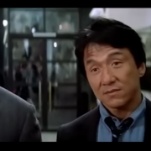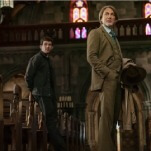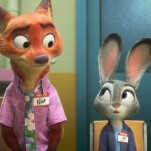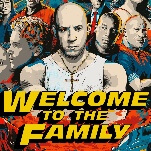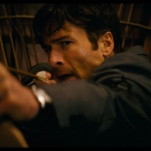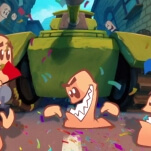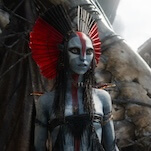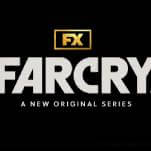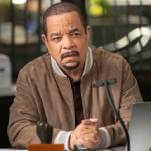Film history isn’t a highlight reel of universally agreed-upon classics. It’s an epic story. But some chapters of the story draw more attention than others. Secret Cinema is a column dedicated to shining a light on compelling little-noticed, overlooked, or faded-from-memory movies from years past. Let’s talk about the films nobody’s talking about.
A couple of weeks ago, I wrote a Films That Time Forgot piece about Bloody Birthday, an evil-kid horror movie shot in 1981 and released in 1986. As films of its type go, it’s pretty entertaining, most notable for featuring evil children and a long nude scene involving future MTV personality Julie Brown. (The non-Downtown one.) A blurb on the cover from the horror-aficionado site eSplatter.com got me thinking: “Disturbing images, a high body count, and plenty of gratuitous sex,” the eSplatter writer enthuses. “There is no doubt that this film could not be made today.”
I think there’s some doubt. The content still fits within the bounds of what’s acceptable for an R rating. But I have no doubt that the film would not be made today, or at least not released in theaters. The blood looks a little too viscous and vivid, with none of the CGI cartoonishness that’s overtaken modern horror films. The camera lingers over the nudity. The sex scene looks a little too full-contact. And the kills, though only slightly less gimmicky than those found in a Final Destination movie, look like they hurt. Horror films today often try to get away with some of the above, but rarely all of them. And those that do—the Hostel films and the awful Friday The 13th remake immediately come to mind—feel like exceptions. Bloody Birthday comes from an era when a robust strain of sleaze was relatively commonplace, even mainstream. Though Birthday sat on the shelf for years, cable used to be populated with casually nasty films. Apart from the brief flare-up of ’00s torture porn, nastiness has now moved to the margins, relegated to obscure pipelines of indie horror and extreme cinema from places like France and Japan.
Permissiveness doesn’t move in a straight line. It ebbs and recedes, leaving marks in the sand at its high points. The ’70s and early ’80s were one such point. The early ’30s were another. In 1930, the Motion Picture Producers And Distributors Of America adopted the Hays Code, a list of self-policing guidelines created in part to head off government pressure. Then, for four years, it more or less forgot about the Code, leading to an era of sex and violence that allowed for everything from Scarface to Mae West to enter the cinematic landscape. It was also the first great era for American horror films.
In his indispensable horror-films study The Monster Show, David J. Skal lays out a multitude of reasons why Hollywood, and American audiences, became fixated on monsters and the supernatural in the early ’30s, with particular attention paid to the Great Depression and the rapidly changing times surrounding it. A chasm had opened beneath the once-stable surface of American society, and the fear it created needed to find some expression. “Cataclysmic junctures in history usually stir up strong imagery in the collective mind,” Skal writes, “and the years following the 1929 economic crash were no exception.” What’s more, the imagery surfacing at the time was of a new sort, the kind that those drafting the Hays Code hadn’t even considered, since there wasn’t anything in Hollywood monster movies to consider at the time.
That left state censorship boards to rise to the challenge, meaning the version of a film shown in one state might be cut in ways the version in the next state wouldn’t. But movies pushed the limits anyway. Murders In The Rue Morgue, an extremely loose 1932 adaptation of Poe’s story in which mad scientist Bela Lugosi injects virgin women with the blood of apes, contains one of the most unpleasant moments I’ve ever seen in a film, a sadistic crucifixion scene conducted by Lugosi on a screaming Arlene Francis. (It’s also a highly inventive movie, and well worth checking out for Karl Freund’s cinematography alone.) The following year’s Murders In The Zoo has a few equally unsettling moments, including one that’s unpleasant for markedly different reasons than the others.
Released in 1933, Murders In The Zoo was Paramount’s third horror film, following Dr. Jekyll And Mr. Hyde and Island Of Lost Souls. Though it’s a horror movie only in the loosest sense—it’s scary and contains many grim moments—it keeps with its predecessors’ key theme by exploring the thin division between humans and animals. It isn’t a particularly good movie, but once seen, it isn’t soon forgotten. Zoo wastes no time getting to its greatest shock of the traditional sort. As the film opens, zooming in on the jungles of French Indochina, Lionel Atwill hunches over the body of a man being held down by three servants. The bound victim struggles a bit, but his grunting and twisting can’t prevent what’s being done to him, an action obscured at first, just barely, by a servant’s body. The film then cuts to the hunched Atwill, his victim just out of frame, as he sews… something. “A Mongolian prince taught me this, Taylor,” he says, addressing the victim. “An ingenious device for the right occasion. You’ll never lie to a friend again. And you’ll never kiss another man’s wife.”
Atwill remains calm the whole time, but he clearly has to work at the task. Whatever he’s stitching together doesn’t give way easily to the needle. Then Atwill and the servants walk away, leaving the unfortunate Taylor to fight off his bonds, stumble to his feet, then lumber directly toward the camera, revealing a mouth that’s been crudely but thoroughly stitched together. Later that night, Atwill’s wife (Kathleen Burke) asks about the absent Taylor. When she hears he’s left, she asks, “What did he say?” Atwill replies, “He didn’t say anything.”
The way Atwill underplays the moment sells it. There’s no camp to his performance. He never winks. He plays it like a madman who’s learned to pass in polite society. The film is a bit like that, too. After that shocking opening, Murders In The Zoo transforms into a fairly rote thriller, following Atwill’s big-game hunter back to America, where he plans to donate the animals he’s captured to a zoo on the edge of financial ruin. He’s brought everything from tigers to chimps to rhinos, apparently the fruit of an extremely long safari. The donation leads the zoo to take a chance by hiring publicist Charlie Ruggles, who’s comically struggling to overcome a past as a drunk, to promote the new arrivals. It also gives a pair of scientist lovebirds (Gail Patrick and Randolph Scott) a new subject in the form of a green mamba, a snake with a bite so deadly, no one has developed an antidote to its venom. Meanwhile, Burke plans to leave Atwill for yet another man who’s caught her eye.
That may sound like a lot more plot than needed for a movie called Murders In The Zoo, and it feels that way, too. Overstuffed even at a mere 62 minutes, Murders is unmistakably the product of the studio system. It finds room for a parade of Paramount contract players to do something or other, even if that something or other gets in the way of the thrust of the movie. Everyone plays to type: Ruggles, soon to portray a big-game hunter himself in Bringing Up Baby, goes through his comic paces. Randolph Scott, years away from the grizzled performances in the Westerns for which he’s now best remembered, does bland leading-man work. And Atwill plays a creep, brilliantly.
In a later scene that rivals the opening for its brutality, Atwill first smothers Burke, then pushes her into a pond filled with hungry alligators. Cut to a long shot of them chomping on something vaguely body-shaped. What makes Murders In The Zoo so unsettling is the way it integrates this nastiness into the fabric of an otherwise unremarkable but highly watchable feature. One moment, Ruggles is fumbling with his words and amusing those around him. The next, someone’s getting fed to the gators. Maybe that wouldn’t seem so shocking if the Hays Code had never been enforced, and we hadn’t grown accustomed to a certain amount of politeness and obfuscation in old studio films. Instead, Murders In The Zoo, Murders In The Rue Morgue, and other films of their ilk feel like a window into an alternate universe in which torture and mutilation could easily be as much a part of an evening at the movies as popcorn.
It’s a window into a different time in other respects, as well. Murders In The Zoo’s climax is even more disturbing than the film’s opening, albeit for different reasons. Cornered in the zoo, Atwill tries to escape via “Carnivora House,” where, in order to create a diversion, he opens the cages housing the zoo’s big cats and lets them run wild. Which they do, on camera, and with no apparent thought to the animals’ safety. The scene lasts less than a minute, but it seems to go on forever. A lion wrestles with a jaguar, panthers run amok, and cats leap from high metal perches onto the concrete floor. All the while, Atwill looks on at the violence approvingly. It’s hard to know what to feel at this point: That the villain enjoys what he sees feels like an implied condemnation, but all this unsimulated animal-on-animal violence didn’t just happen. It was orchestrated for our entertainment. It’s a vestige of a time before the American Humane Association and its “No Animals Were Harmed” disclaimer, and before most people questioned whether animals should suffer for our amusement.
That’s true of the zoo around Murders In The Zoo as well, which looks pretty grim to modern eyes, filled with none-too-spacious habitats and some suspect ideas of animal care. One scene includes an exhibit in which visitors feed chained bear cubs from baby bottles, an arrangement that doesn’t look too happy for the little bears. Zoos thankfully moved on, eventually. (I can still remember seeing truly distressed animals during zoo visits as a child in the ’70s.) But the ugly practices of yesterday remain a part of their history. That’s true of film, as well, which sometimes allows us to see the past laid bare. The lurid content assured that, two years after its release, Murders In The Zoo couldn’t have been made. Its treatment of animals, to echo the eSplatter writer, leaves no doubt in my mind that Murders In The Zoo could not be made today, either. That’s fine. Part of what makes it fascinating also makes it horrible. It’s a document of a different sort of permissiveness, best left in the past.
Next: God Of Gamblers (1989)
Then: They Came To Rob Las Vegas (1968)






























